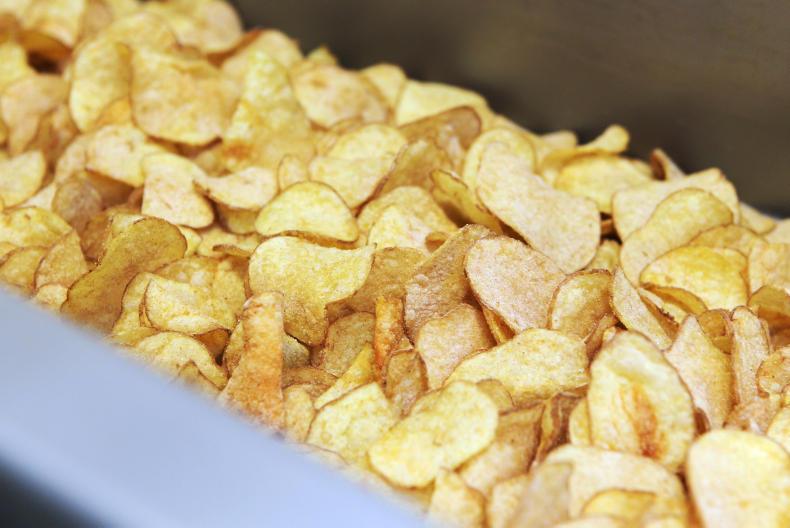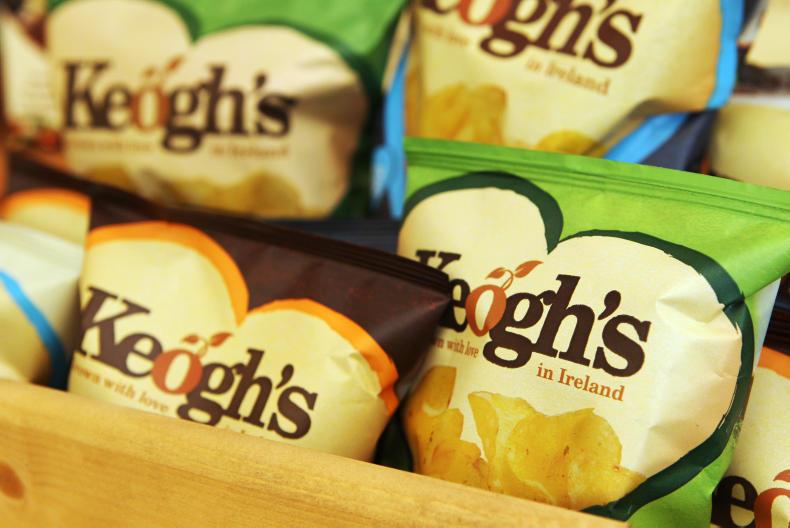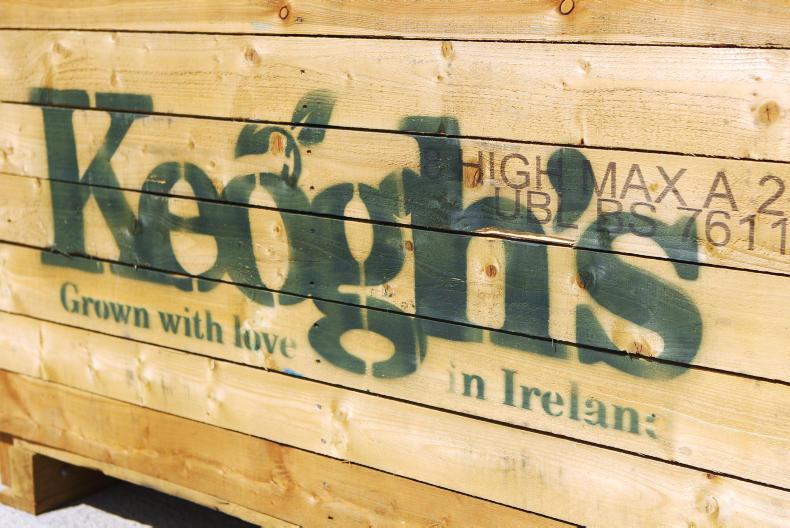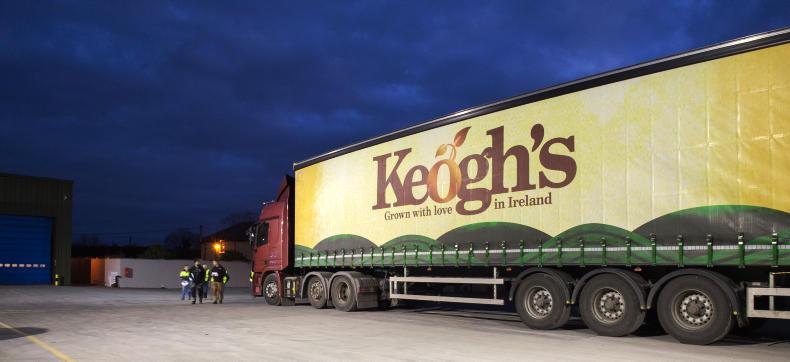It’s November and the back roads around north Co Dublin are alive with farming activity. This is potato country and Dublin’s growers are trying their best to harvest the 2019 potato crop.
North Dublin is a real farming powerhouse with about 65% of all Ireland’s fresh produce and vegetables grown or packed in this part of the country.
However, the incessant rain for much of the past two months has made this year’s potato harvest very difficult and progress is painfully slow.
We’ve 80 acres of potatoes still in the ground, which is about 20% of our crop
Tom Keogh, a potato grower in Ballyboughal, Co Dublin, and managing director of the much-loved Keogh’s crisps brand, still has about 20% of his family’s potato crop in the ground.

“We’ve 80 acres of potatoes still in the ground, which is about 20% of our crop. It’s not looking like we’ll get them before Christmas so those potatoes will likely now overwinter.
“And when a crop is overwintered, you can write-off at least half of it,” says Keogh.
The one saving grace this harvest has been the power of modern farm machinery, says Keogh.
“It’s incredible the work that machinery can do today. The fields are that wet I could barely stand in them but the harvesters were still able to dig potatoes.
“It’s amazing how advancements in technology can enable you to continue to work despite the poor weather,” he explains.
According to Keogh, it’s been a beautiful growing season up to October
The great pity about the difficult harvest conditions this year for potato growers was the yield potential of the crop.

According to Keogh, it’s been a beautiful growing season up to October. In contrast to last summer’s drought, the 2019 potato crop had sun at the right time and rain when it needed it.
The potatoes that have been harvested have yielded really well and the quality is very good.
For Keogh’s, October and November is doubly busy compared with other farms in the area.
The potato harvest is grinding forward but, at the same time, the family-run business is scrambling to fill Christmas orders from retailers for the Keogh’s range of crisps.
It’s less than 10 years since Tom Keogh first established the Keogh’s crisp brand but the business has grown rapidly in that time.
Today, we’re operating four crisp fryers and have a bagging capacity of up to 300 bags of crisps per minute
“We started in 2011 with just one potato fryer. We were hand-filling potatoes into the slicer, frying them and bagging 20 bags of crisps per minute.
“Today, we’re operating four crisp fryers and have a bagging capacity of up to 300 bags of crisps per minute,” says Keogh.
When he first got the idea to start making crisps on the farm, Tom Keogh approached the local enterprise board in the area for some funding to help with the significant capital expenditure of starting the business.

This startup finance was fully repayable but it helped get the crisp business off the ground, says Keogh.
The fledgling crisp company found its point of difference by producing a high-end artisan crisp and targeted the more discerning consumer who is willing to pay a bit more for a premium food product.
The brand took off, not only in Ireland (Irish consumers are among the highest crisp eaters in the world), but Keogh’s was able to develop an export business very early on.
By 2014, the business had reached production capacity and another capital investment was needed to expand.
With 12 employees at this stage, Keogh’s now found itself as a client of Enterprise Ireland (EI) and plans were drawn up to double capacity at the on-farm crisping facility.
“This was a very substantial project for the business and very capital-intensive but EI came on board with some capital funding. The investment doubled our output at the time,” says Keogh.
We were reaching capacity again so we developed a plan for another significant capital investment to increase the capacity of the factory
Around the same time, Keogh took part in EI’s Leadership 4 Growth programme, which he says was a complete eye-opener for him.
“Out of the Leadership 4 Growth programme, I developed a long-term plan for the crisp business. EI likes to see you thinking about the long-term picture,” he says.

“We were reaching capacity again so we developed a plan for another significant capital investment to increase the capacity of the factory. In March 2018, we completed the project. We put in a new line to start making popcorn.
“We also put in more bagging machines and added more crisp fryers. This brought us up to another level when it came to supply and allowed us some headspace,” says Keogh.
Despite this recent investment, Keogh continues to think long-term about the business.

Today, just over 20% of sales are coming from export markets. By 2020, Keogh’s forecasts that exports will account for 30% of sales.
Right now, the United Arab Emirates (thanks to a very fruitful partnership with Emirates airlines) and the US are the two major export destinations for Keogh’s crisps.
To meet this growing export demand, Keogh’s is planning a bespoke, standalone on-farm crisp factory
Even with the UAE in recession and the US changing its trade policy by the week, demand from both these markets is rising year after year.
To meet this growing export demand, Keogh’s is planning a bespoke, standalone on-farm crisp factory that will secure production capacity well into the years ahead.
For a company that’s still relatively young, Keogh’s is a food business that’s got plans for the long-haul, regardless of the wet weather this winter.
It’s November and the back roads around north Co Dublin are alive with farming activity. This is potato country and Dublin’s growers are trying their best to harvest the 2019 potato crop.
North Dublin is a real farming powerhouse with about 65% of all Ireland’s fresh produce and vegetables grown or packed in this part of the country.
However, the incessant rain for much of the past two months has made this year’s potato harvest very difficult and progress is painfully slow.
We’ve 80 acres of potatoes still in the ground, which is about 20% of our crop
Tom Keogh, a potato grower in Ballyboughal, Co Dublin, and managing director of the much-loved Keogh’s crisps brand, still has about 20% of his family’s potato crop in the ground.

“We’ve 80 acres of potatoes still in the ground, which is about 20% of our crop. It’s not looking like we’ll get them before Christmas so those potatoes will likely now overwinter.
“And when a crop is overwintered, you can write-off at least half of it,” says Keogh.
The one saving grace this harvest has been the power of modern farm machinery, says Keogh.
“It’s incredible the work that machinery can do today. The fields are that wet I could barely stand in them but the harvesters were still able to dig potatoes.
“It’s amazing how advancements in technology can enable you to continue to work despite the poor weather,” he explains.
According to Keogh, it’s been a beautiful growing season up to October
The great pity about the difficult harvest conditions this year for potato growers was the yield potential of the crop.

According to Keogh, it’s been a beautiful growing season up to October. In contrast to last summer’s drought, the 2019 potato crop had sun at the right time and rain when it needed it.
The potatoes that have been harvested have yielded really well and the quality is very good.
For Keogh’s, October and November is doubly busy compared with other farms in the area.
The potato harvest is grinding forward but, at the same time, the family-run business is scrambling to fill Christmas orders from retailers for the Keogh’s range of crisps.
It’s less than 10 years since Tom Keogh first established the Keogh’s crisp brand but the business has grown rapidly in that time.
Today, we’re operating four crisp fryers and have a bagging capacity of up to 300 bags of crisps per minute
“We started in 2011 with just one potato fryer. We were hand-filling potatoes into the slicer, frying them and bagging 20 bags of crisps per minute.
“Today, we’re operating four crisp fryers and have a bagging capacity of up to 300 bags of crisps per minute,” says Keogh.
When he first got the idea to start making crisps on the farm, Tom Keogh approached the local enterprise board in the area for some funding to help with the significant capital expenditure of starting the business.

This startup finance was fully repayable but it helped get the crisp business off the ground, says Keogh.
The fledgling crisp company found its point of difference by producing a high-end artisan crisp and targeted the more discerning consumer who is willing to pay a bit more for a premium food product.
The brand took off, not only in Ireland (Irish consumers are among the highest crisp eaters in the world), but Keogh’s was able to develop an export business very early on.
By 2014, the business had reached production capacity and another capital investment was needed to expand.
With 12 employees at this stage, Keogh’s now found itself as a client of Enterprise Ireland (EI) and plans were drawn up to double capacity at the on-farm crisping facility.
“This was a very substantial project for the business and very capital-intensive but EI came on board with some capital funding. The investment doubled our output at the time,” says Keogh.
We were reaching capacity again so we developed a plan for another significant capital investment to increase the capacity of the factory
Around the same time, Keogh took part in EI’s Leadership 4 Growth programme, which he says was a complete eye-opener for him.
“Out of the Leadership 4 Growth programme, I developed a long-term plan for the crisp business. EI likes to see you thinking about the long-term picture,” he says.

“We were reaching capacity again so we developed a plan for another significant capital investment to increase the capacity of the factory. In March 2018, we completed the project. We put in a new line to start making popcorn.
“We also put in more bagging machines and added more crisp fryers. This brought us up to another level when it came to supply and allowed us some headspace,” says Keogh.
Despite this recent investment, Keogh continues to think long-term about the business.

Today, just over 20% of sales are coming from export markets. By 2020, Keogh’s forecasts that exports will account for 30% of sales.
Right now, the United Arab Emirates (thanks to a very fruitful partnership with Emirates airlines) and the US are the two major export destinations for Keogh’s crisps.
To meet this growing export demand, Keogh’s is planning a bespoke, standalone on-farm crisp factory
Even with the UAE in recession and the US changing its trade policy by the week, demand from both these markets is rising year after year.
To meet this growing export demand, Keogh’s is planning a bespoke, standalone on-farm crisp factory that will secure production capacity well into the years ahead.
For a company that’s still relatively young, Keogh’s is a food business that’s got plans for the long-haul, regardless of the wet weather this winter.











 This is a subscriber-only article
This is a subscriber-only article










SHARING OPTIONS: